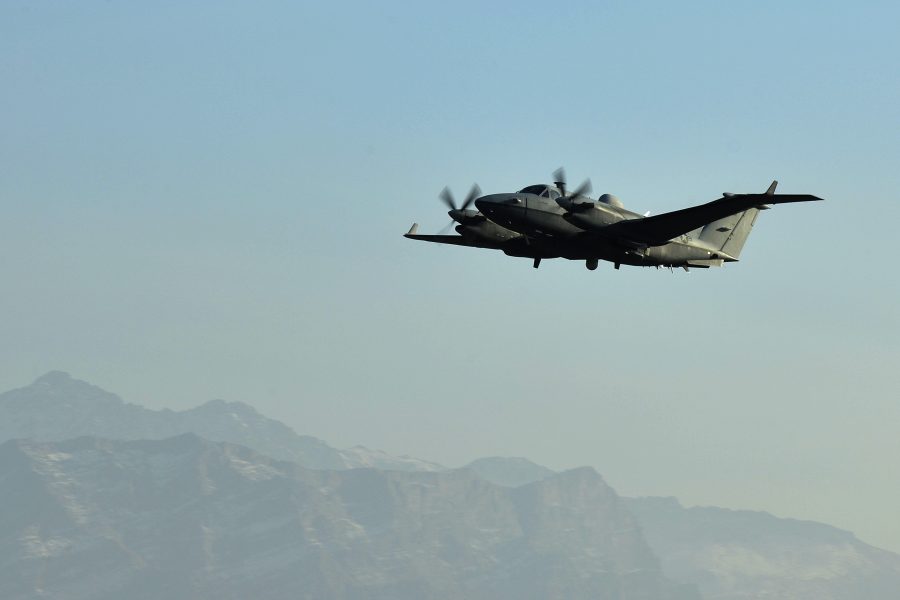A Russian fighter harassed a U.S. manned surveillance aircraft over Syria on July 16, engaging in a maneuver that risked the lives of the four American crew members, U.S. officials said July 18.
The move comes as escalating tensions with Iran and Russia have led the Pentagon to order more forces, including fifth-generation F-35s and F-16 fighter jets to the region.
“We’ve got adequate capabilities to defend ourselves,” Chairman of the Joint Chiefs of Staff Army Gen. Mark A. Milley told reporters at the Pentagon July 18.
Milley cautioned that the U.S. was unsure what is behind Russia’s recent behavior, but U.S. officials have noted a closer defense partnership between Iran and Russia as of late.
“We’re monitoring it very closely,” Milley said. “As to the reason why [there has been] the little bit of an uptick, I’m not really certain. We’ve got analysts trying to figure that out.”
Some U.S. officials have suggested Russian pilots and commanders may be trying to pressure U.S. forces to leave Syria, where U.S. forces have been helping partners fight the remnants of ISIS.
The July 16 incident began at around 6:45 pm Syria time, when a Russian Su-35 fighter caught a U.S. MC-12 Liberty on an intelligence-gathering mission against ISIS, according to the Department of Defense’s account of the incident. The Russian Su-35 flew in the flight path of the MC-12, a small turboprop plane based on the civilian Beechcraft King Air 350, forcing the U.S. plane to fly through the fighter’s wake turbulence.
“This reduced the crew’s ability to safely operate the aircraft and put the four crewmembers’ lives at risk,” Air Forces Central (AFCENT) commander Lt. Gen. Alexus G. Grynkewich said in a statement. “These actions against a manned aircraft represent a new level of unsafe and unprofessional actions by Russian aircraft operating in Syria. We strongly urge Russian forces in Syria to cease reckless and threatening behavior that could result in an accident and loss of life, and adhere to the standards of behavior expected of a professional force.”
The Associated Press first reported details of the incident, which was was similar to other near confrontations with U.S. adversaries in recent months.
In May, a Chinese fighter flew in the path of a U.S. RC-135, another intelligence plane, over the South China Sea. The jet wash from the Chinese fighter caused the RC-135, which is related to the Boeing 707 jetliner, to experience severe turbulence. The encounter was captured on video from the RC-135’s cockpit, which the Pentagon released.
Two Russian Su-27 pilots harassed a U.S. MQ-9 over the Black Sea in March, with one Russian fighter clipping the American drone, which the Pentagon said made the drone uncontrollable and forced the operator to intentionally crashed the MQ-9 into the water.
The DOD has also released videos of other Russian interactions with U.S. drones, which have included acts such as dropping parachute flares and engaging a fighter’s jet engine afterburner in front of MQ-9s.
But the Pentagon did not publicize video footage of the July 16 incident between the Su-35 and MC-12. A U.S. official said high-quality, publicly releasable video from the MC-12 was unavailable. U.S. officials did not say how close the Su-35 got to the MC-12.
The incident happened a day before the Pentagon announced additional forces were heading to CENTCOM, including the guided missile destroyer USS Thomas Hudner.
Just days before that, Russia overflew the U.S. outpost of Al Tanf Garrison in eastern Syria with an An-30, which like the American MC-12 is a crewed turboprop ISR aircraft.
Armed Russian aircraft have also been regularly overflying U.S. troops in eastern Syria and getting as close as 500 feet to manned U.S. fighters since March 1.
Milley said the U.S. forces had the proper authorities to operate safely in Syria, where the U.S. has 900 ground troops working with Kurdish groups to battle the remnants of ISIS. American fighter aircraft, which are usually armed with air-to-ground and air-to-air weapons when flying over Syria, supplement and protect those troops. The U.S. also uses platforms such as MQ-9s for ISR and airstrikes.
“We have rules of engagement,” Milley told reporters at the Pentagon. “If at any point in time any of our troops sense a hostile act, a hostile intent, they will protect themselves.”
But the July 16 incident fell below that threshold, Milley said.
“If there’s unsafe or unprofessional acts, that’s a different issue,” Milley said. “We try to work that out through the deconfliction channel that’s going on at the tactical level, so that we don’t have an inadvertent air-to-air accident or incident.”
Milley added he was confident the U.S. has enough forces in the region following the latest announcement. However, it is unclear when the additional fighters will arrive.
A senior U.S. defense official told Air & Space Forces Magazine that the F-35s could be used around the Strait of Hormuz, where Iran has attempted to seize oil tankers, if the airspace became contested. But the F-35s could also be used over Syria if Russia presented a more significant threat, the official said. F-22 Raptors were deployed to the region in June and are departing.
“Having that fifth-gen capability up in Syria doing defensive counterair gives us more capacity up there,” the senior U.S. defense official said. “It’s effective against some of those Russian provocations that we’ve previously countered with the F-22.”


